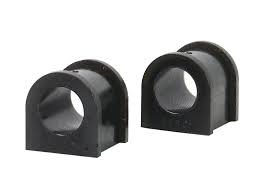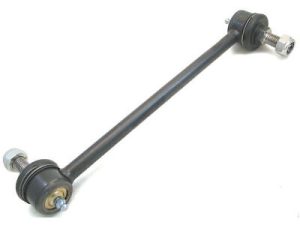When upgrading or maintaining your vehicle’s suspension, one of the often-overlooked components is the sway bar bushing. These bushings connect the sway (stabilizer) bar to the chassis, allowing it to twist under load while controlling body roll. The material used for these bushings significantly influences how effective the sway bar is, how long the assembly lasts, and how the vehicle feels.
In this article, we’ll explore different bushing materials, their trade-offs, how they affect sway bar performance and durability, and best practices for selecting and maintaining them.
Why Bushing Material Matters

The sway bar must rotate slightly within its mounts as the suspension moves. That rotation happens through the bushings. The properties of material — stiffness, friction, wear resistance, damping, etc. — determine:
-
How freely the bar can rotate
-
How much “play” or deflection occurs
-
How much NVH (noise, vibration, harshness) is transmitted
-
How long the bushing lasts under load, heat, and exposure
A poor bushing choice can degrade handling, introduce noise or squeaks, and lead to premature wear in the bar, mounts, or chassis brackets.
Common Bushing Materials: Pros & Cons
Here are the main materials used for sway bar bushings:
| Material | Hardness / Flexibility | Advantages | Disadvantages / Trade-offs | Typical Use Cases |
|---|---|---|---|---|
| Rubber (synthetic rubber / elastomer) | Soft to medium | Excellent vibration isolation, quiet operation, forgiving under minor misalignment | Prone to aging, degradation from heat, oil, UV; more deflection under load | OEM / street / comfort focus |
| Polyurethane (urethane / “poly”) | Medium to stiff | Longer life, better dimensional stability, more direct handling | Increased noise or harshness, requires lubrication, may squeak | Sport / performance / upgraded suspensions |
| Thermoplastic / Composite Elastomers | Intermediate | More durable than rubber, less harsh than stiff urethane | Some compromise in performance extremes | Upgraded OEM or mid-performance upgrades |
| Delrin / Nylon / Hard Plastics (sometimes in inserts) | Very stiff | Low wear, precise control | Usually too rigid for full bushing alone—used as inserts or in specialized cases | Racing, bespoke suspension builds |
Many guides compare polyurethane vs rubber bushings in sway bar usage.
How Material Affects Sway Bar Efficiency
Let’s break down the performance effects:
1. Rotation / Friction Losses
A very soft rubber bushing may allow slight slack or deflection before the bar fully exerts torque. This “dead travel” reduces the effective stiffness of the sway bar. Conversely, too rigid a bushing may bind or add friction, increasing wear.
2. NVH (Noise, Vibration, Harshness)
Soft rubber offers high damping, absorbing small vibrations and isolating road noise. Polyurethane or hard materials transmit more vibration to the chassis, making the ride harsher, especially on rough surfaces.
3. Durability and Aging
Rubber degrades with time, heat, exposure to oils, UV, and ozone. Cracks, hardening, or permanent deformation are common failure modes. Polyurethane is much more resistant to those factors, but it can wear on sharp edges or in abrasive conditions, and may squeak when dry.
4. Load Handling and Precision
Stiffer bushings reduce flex, ensuring the sway bar’s resistance to roll is more directly used. This improves the precision of handling, especially under cornering loads. However, excessive stiffness may upset suspension compliance elsewhere.
Balancing Material Choice: What to Consider
To choose a bushing material wisely, consider the following factors:
-
Vehicle usage & priorities: Daily driver vs track car
-
Road conditions: Smooth highways or rough terrain
-
Noise tolerance: Are squeaks acceptable?
-
Maintenance considerations: Need for regular greasing?
-
Load & handling goals: How sharp do you want the response?
Here’s a quick decision guide:
| Priority | Recommended Material | Why |
|---|---|---|
| Quiet, comfortable ride | Rubber or soft composite | Best damping, low NVH |
| Sporty handling with durability | Medium or hard polyurethane | Good precision and life |
| Racing or extreme conditions | Dual-durometer poly, inserts, or composite | Maximum control and wear resistance |
| Compromise / balanced choice | Thermoplastic or good quality poly | Middle ground between rubber and stiff poly |
Best Practices, Maintenance & Longevity
Even a high-quality bushing material requires attention:
-
Proper Lubrication
Many polyurethane or composite bushings require grease (silicone-based or specified) to prevent squeaking and reduce friction. If they run dry, they can squeak or wear prematurely. -
Correct Fit & Preload
Bushings should wrap well around the sway bar and mount with minimal binding. Over-tightening can distort them, under-tightening leads to slop. -
Inspect Regularly
Check annually (or during suspension maintenance) for cracks, distortion, or degradation. Replace bushings showing wear. -
Use Quality Parts
Low-cost bushings may use inferior formulations; investing in higher-grade material pays off in longevity and performance. -
Replace in Pairs
Always change bushings on both sides simultaneously to maintain balanced response. -
Consider Hybrid Solutions
Some setups use a rubber shell with polyurethane inserts or layered materials for a mix of comfort and control.
Example Bushing Products & Recommendations

Here are some commonly used sway bar bushing components you might consider:
-
Moog K202015 Stabilizer Bar Bushing Kit – quality OEM-style rubber kit
-
Prothane Universal Sway Bar Bushings 19‑1110 – greasable polyurethane upgrade
-
Energy Suspension 3.5213R Sway Bar Bushing Set – performance poly set
-
Front Anti Roll / Sway Bar Bush Kit – generic front kit
-
Moog K200839 Sway Bar Bushing Kit – another OE-replacement option
-
Rough Country Sway Bar Bushing – heavy-duty/aftermarket variant
These represent a range from OEM rubber to performance polyurethane options.
Summary & Final Recommendations
-
The choice of bushing material has profound impact on sway bar efficiency, handling, NVH, and durability.
-
Rubber offers compliance and comfort but degrades over time and under stress.
-
Polyurethane and harder composites offer better longevity and handling precision but may increase noise and require maintenance.
-
For a balanced setup, choose a material and durometer suited to your driving style, road conditions, and tolerance for harshness.
-
Use proper installation, greasing, inspection, and quality components to maximize lifespan.
When you’re ready to upgrade or replace your sway bar bushings, you can find suitable parts at your convenience — check out Stabilizer & Components online for a selection of options that match your vehicle’s needs.